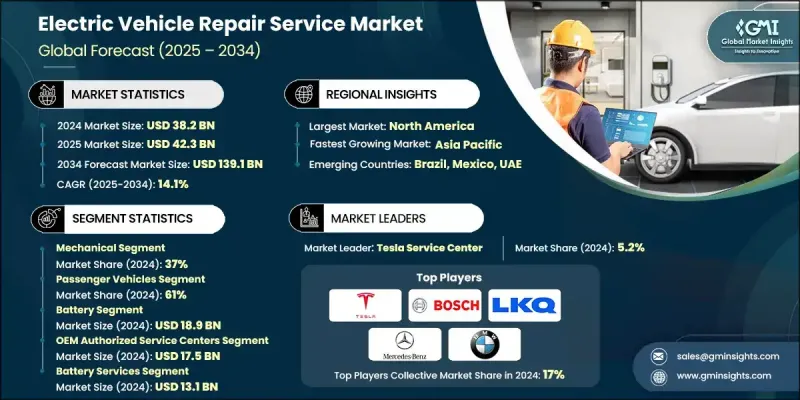
|
市場調査レポート
商品コード
1876823
電気自動車修理サービス市場の機会、成長要因、業界動向分析、および2025年から2034年までの予測Electric Vehicle Repair Service Market Opportunity, Growth Drivers, Industry Trend Analysis, and Forecast 2025 - 2034 |
||||||
カスタマイズ可能
|
|||||||
| 電気自動車修理サービス市場の機会、成長要因、業界動向分析、および2025年から2034年までの予測 |
|
出版日: 2025年11月10日
発行: Global Market Insights Inc.
ページ情報: 英文 235 Pages
納期: 2~3営業日
|
概要
世界の電気自動車修理サービス市場は、2024年に382億米ドルと評価され、2034年までにCAGR14.1%で成長し、1,391億米ドルに達すると予測されています。

電気自動車の普及が世界的に加速する中、業界は著しい成長を遂げております。これは電気自動車のフリート拡大と、高度なメンテナンス・診断技術への需要増加に支えられております。電気自動車のアーキテクチャが複雑なパワートレイン、大容量バッテリーシステム、インテリジェントソフトウェアへと進化するにつれ、サービスプロバイダーは運用効率の向上とデジタルサービス統合に注力しております。接続性・自動化・データ駆動型のメンテナンスモデルへの移行は、精密診断と予知保全を重視した従来の自動車修理手法を変革しております。スマートでAI対応の修理エコシステムの出現は、サービスネットワークに革命をもたらし、信頼性の向上、ダウンタイムの削減、コスト効率の改善を実現しています。IoT対応診断、クラウドプラットフォーム、AIベースの故障検出の活用拡大により、サービスネットワークはリアルタイムの健康状態追跡と遠隔メンテナンスを提供できるようになりました。OEMサービスセンター、独立系修理工場、フリート運営者間の統合は、EVメンテナンス業務における透明性、対応力、長期的な持続可能性を高める、コネクテッドサービスインフラを強化しています。
| 市場範囲 | |
|---|---|
| 開始年 | 2024年 |
| 予測年度 | 2025-2034 |
| 開始時価値 | 382億米ドル |
| 予測金額 | 1,391億米ドル |
| CAGR | 14.1% |
機械セグメントは2024年に37%のシェアを占め、2025年から2034年にかけてCAGR16.6%で成長すると予測されています。駆動系、回生ブレーキ、サスペンション、高電圧アセンブリなどの機械システムは、EVの性能と安全性の基盤を構成しております。これらのシステムがますます複雑化するにつれ、専門的な修理工具、熟練技術者、高度な診断機器への需要が継続的に高まっており、このセグメントの成長を牽引しております。
乗用車セグメントは2024年に61%のシェアを占め、2034年までCAGR16.1%で成長すると予測されています。このセグメントの成長は、電気自動車およびハイブリッド車の生産急増、厳格な環境政策、予測保全ソリューションの普及拡大に起因しています。自動車メーカーやサービスプロバイダーは、テレマティクスベースのプラットフォーム、AI駆動型診断、高度なバッテリー評価ツールへの投資を進めており、これにより精度向上、サービス効率化、長期的な車両信頼性の確保を図っています。
米国電気自動車修理サービス市場は88%のシェアを占め、117億米ドルを生み出しました。同地域は、堅牢な自動車製造インフラとサービス業務の広範なデジタル化に支えられ、EVサービス革新における主要なリーダーであり続けています。米国市場は、AI対応診断、IoTベースの監視システム、クラウド統合プラットフォームなどの技術を採用し、OEM、独立系ガレージ、フリートサービスからなるネットワーク全体でシームレスなEVメンテナンス業務を確保しています。
世界の電気自動車修理サービス市場で活動する主要企業には、テスラサービスセンター、LKQ、トヨタ自動車、BMW、メルセデス・ベンツ、ボルボ、BYD、フォルクスワーゲン、ロバート・ボッシュ、HEVRAなどが挙げられます。電気自動車修理サービス市場の主要企業は、技術統合、サービス拡大、従業員のスキル向上を中心とした戦略的取り組みを採用しています。修理業務の効率化と納期短縮のため、AI駆動型診断、IoT対応監視ツール、クラウドベースのメンテナンスシステムを導入しています。OEMと独立系サービスセンター間の提携が拡大し、修理サービスのアクセシビリティと標準化が図られています。また、高電圧システムやバッテリー診断の取り扱いに関する技術的専門性を高めるため、認定EV技術者育成プログラムの構築も進められています。
よくあるご質問
目次
第1章 調査手法と範囲
第2章 エグゼクティブサマリー
第3章 業界考察
- エコシステム分析
- サプライヤーの情勢
- 利益率
- コスト構造
- 各段階における付加価値
- バリューチェーンに影響を与える要因
- ディスラプション
- 業界への影響要因
- 促進要因
- 電気自動車の普及拡大
- 電気自動車修理ツールの技術的進歩
- 政府によるEVインフラ規制と補助金
- アフターマーケットにおけるEV部品の供給拡大
- 業界の潜在的リスク&課題
- 専門的なEV修理の高コスト
- 熟練技術者の不足
- 市場機会
- 電気自動車(EV)フリートメンテナンスサービスの拡大
- 予知保全とAI診断の統合
- フリートベースのサービス契約と予知保全
- モバイルEVサービスとオンデマンド修理ソリューション
- 促進要因
- 成長可能性分析
- 規制情勢
- 安全性と高電圧対応
- 環境及びバッテリーリサイクルに関する規制
- 修理権と知的財産権
- 排出量とエネルギー規制への対応
- ポーター分析
- PESTEL分析
- 技術とイノベーションの動向
- バッテリー診断・熱管理技術
- 高電圧システムの修理と安全性
- 充電システムのメンテナンスとEVSE技術
- ソフトウェア、診断及びOTAサービス
- 従来の機械式サービス技術
- 技術導入とデジタルトランスフォーメーション
- 診断におけるAIおよび機械学習の応用
- IoTおよびコネクテッドカーデータの活用
- テレマティクスおよび遠隔診断機能
- サービス管理のためのモバイルアプリとデジタルプラットフォーム
- コネクテッドサービスにおけるサイバーセキュリティへの影響
- 価格動向
- 地域別
- 製品別
- 生産統計
- 生産拠点
- 消費拠点
- 輸出と輸入
- コスト内訳分析
- 特許分析
- 持続可能性と環境的側面
- 持続可能な実践
- 廃棄物削減戦略
- 生産におけるエネルギー効率
- 環境に配慮した取り組み
- ベストケースシナリオ
- 消費者行動とサービス嗜好
- 電気自動車修理サービスに対するお客様の期待
- 保証およびサービスプランの嗜好
- デジタルサービス予約と透明性の動向
- ブランドロイヤルティと乗り換え傾向
- サービス導入における地域差
- 顧客生涯価値と顧客維持
- 代替サービス提供モデル
- 将来展望と戦略的提言
第4章 競合情勢
- イントロダクション
- 企業の市場シェア分析
- 北米
- 欧州
- アジア太平洋地域
- ラテンアメリカ
- 中東・アフリカ
- 主要市場企業の競合分析
- 競合ポジショニングマトリックス
- 戦略的展望マトリックス
- 主な発展
- 合併・買収
- 提携・協業
- 新製品の発売
- 事業拡大計画と資金調達
第5章 市場推計・予測:コンポーネント別、2021-2034
- 主要動向
- 機械部品
- 外装
- 構造
- その他
第6章 市場推計・予測:車両別、2021-2034
- 主要動向
- 乗用車
- ハッチバック車
- セダン
- SUV
- 商用車
- 小型商用車(LCV)
- 中型商用車(MCV)
- 大型商用車(HCV)
第7章 市場推計・予測:サービス別、2021-2034
- 主要動向
- バッテリーサービス
- 高電圧システムの修理
- 充電システムの保守
- ソフトウェア及び診断
- 従来の機械サービス
第8章 市場推計・予測:推進力別、2021-2034
- 主要動向
- バッテリー
- プラグイン
- 燃料電池
第9章 市場推計・予測:サービスプロバイダー別、2021-2034
- 主要動向
- フランチャイズ一般修理
- OEM認定サービスセンター
- その他
第10章 市場推計・予測:地域別、2021-2034
- 主要動向
- 北米
- 米国
- カナダ
- 欧州
- 英国
- ドイツ
- フランス
- イタリア
- スペイン
- ベルギー
- オランダ
- スウェーデン
- アジア太平洋地域
- 中国
- インド
- 日本
- オーストラリア
- シンガポール
- 韓国
- ベトナム
- インドネシア
- ラテンアメリカ
- ブラジル
- メキシコ
- アルゼンチン
- 中東・アフリカ地域
- アラブ首長国連邦
- 南アフリカ
- サウジアラビア
第11章 企業プロファイル
- Global Player
- BMW
- BYD
- LKQ
- Mercedes-Benz
- NIO
- Robert Bosch
- Tesla
- Toyota Motor
- Volkswagen
- Volvo
- Regional Player
- Axalta Coating Systems
- ChargePoint
- Electrify America
- EVgo
- GoMechanic
- HEVRA Europe OU
- RAD AIR Complete Car Care
- SK Innovation
- The Hybrid Shop
- YCC Service Center
- 新興企業
- Certified Service
- Earthling Automotive
- Qmerit

